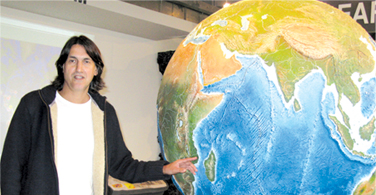

 |
| Professor Jason Ali |
The study, published in Nature, shows that ocean currents periodically flowing between Africa and Madagascar, 60 to 20 million years ago, would have made the trip not only possible, but likely too, given that the currents were unusually fast.
The rafting hypothesis is not new. It was first mooted in 1915, but it was the palaeontologist and evolution theorist, George Simpson, who expanded the theory in a 1940 paper.
"Simpson explored the theory of land bridges," says Professor Ali. "And came up with a set of rules. When he applied them to Madagascar he noted that the creatures that got across were very unusual, because they're of a particular body type – small, with a low metabolic rate, and often with an ability to go into a type of torpor. You can basically turn them off. So things like rodents and small primates could probably have got across."
Simpson introduced the 'sweepstake process' to explain the island's unique biodiversity. If the animals had travelled to Madagascar along a land bridge, he said, large mammals such as elephants and giraffes would also have made the journey. And, as a geologist, Professor Ali agrees that the land bridge theory is "simply untenable."
In his previous research, on modelling past tectonic plate movements, in particular the India-Asia collision, Professor Ali kept running across the land bridge hypothesis used by biologists to explain how creatures from one continent arrived on another. "They were taking the plate tectonic model which is very very robust, and shuffling it around willy nilly. But there are some very tight rules, and I kept thinking these guys were wrong but, because no geologists were reviewing their papers, they were getting away with it.
"Each of the four groups of animals – tenrecs (insect-eating mammals), lemurs, carnivorans and rodents – arrived in four single events between 60 and 20 million years ago," he says. Not in a continuous flow as one might expect across a bridge.
But the rafting hypothesis has also thrown up problems; the present-day currents and prevailing winds between Madagascar and Africa flow south and southwest, away from the island, so creatures or debris washed off Africa's coast would be swept south, not east.
A background in oceanography made him think the currents may have changed over millennia. So he contacted Huber, a paleoclimatologist who reconstructs the Earth's ancient ocean currents using a supercomputer, and asked him to model conditions 40 million years ago. Huber was able to show that Simpson's 'sweepstakes' theory could have worked; the currents at the time were favourable for a crossing that would have taken 25–30 days, short enough to get small animals, with low metabolic rates, across the Mozambique Channel. He also showed that the area was a hotspot for powerful cyclones capable of washing trees, i.e. potential rafts, into the oceans.
"What he found in a 100 year pattern is extreme events, with fairly fast flows," says Professor Ali."What is very unlikely on a short time scale becomes, on a geological timescale, more and more probable." About 20 million years ago the arrivals stopped.
Crucially, at the same time the flow between Africa and Madagascar was disrupted by the move northwards of Madagascar which punched through into the ocean circulation system, altering the currents. This means the flow between the two continents gradually weakened, closing off the 'sweepstakes process'.
"The key thing is the stopping," says Professor Ali. "It's not just the act of creatures arriving during this period, but that you switch off the process [of arrival]. That's an extra piece of information that you can use in the puzzle."
"Madagascar is home to a bizarre series of animals, its reptiles are practically totally endemic, its amphibians are 99 per cent endemic, and the terrestrial animals are certainly 100 per cent. They are all really weird shapes. Once they arrive this whole experiment with life takes off, and you end up with this incredible variety and sometimes in strange forms."
The island's unique biodiversity has made it a living laboratory for evolutionary scientists but the puzzle has always been, how did they get there?
"This study is important," says Professor Ali, "because it shows the process of colonization. We've answered a question that biologists have pondered for a very long time."